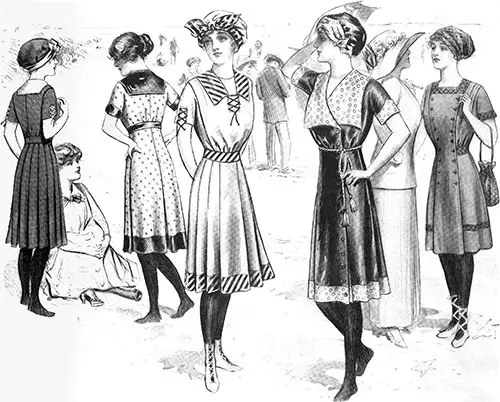Several Designs for Bathing Suits - 1911

Bathing Suit Designs (l-r): 4657 4647 4657 4647 4618
The new designs for bathing-suits embody all the style features that are noteworthy in other dress constructions. Design 4657 consists of a waist with side body and sleeve in one with the underarm gore, which will aid immeasurably in fitting the sleeve and contributing greater ease in the action of the arms.
A plait over the shoulder is stitched the entire length of the back and to a certain depth in front, and the fullness is gathered into the belt which covers the joining of the skirt to the waist. The blouse may be finished with a high or open neck; and the collar in sailor effect may be made with either of two outlines in front.
The straight skirt is plaited. Knickerbockers are worn under the costume. Light-weight Serge, mohair, brilliantine, and flannel are the fabrics most commonly employed for these garments; but satin or silks are also used.
The heightened waistline is the striking feature of design 4647 which comprises a waist with body and sleeve in one, the essential underarm gore and the possibility of a high or open neck and either of two outlines for the collar.
The attached skirt is composed of five gores, with a backward-turning plait at each side seam and an inverted plait at the back. (Knickerbockers attachéd to an underbody are also worn with this suit.)
One-tone materials appear better adapted to the model than the all-over designs—unless the latter are somewhat restrained in their outlines.
One could hardly imagine a smart bathing-suit constructed of a fabric displaying loud floral effects identified with certain wall-papers -it would be altogether incongruous.
The blue-and-white bathing-suit was once considered comme il faut, but now those gloomy serges and demure decorations are no longer approved.
The woman who discriminates in dress avoids glaring colors; she chooses something artistic and becoming; and she studies the environment. A clever panel effect is arranged in design 4618, a bathing-suit whose waist is built on the kimono lines—the side body and sleeve in one.
An underarm gore is also a part of this construction, and a high or Dutch square neck may be adopted. The panel front and back are in one with the front and back gores of the six-piece skirt.
The skirt hangs straight from the waist, and it is unadorned, save by braid or the slightly circular band across the sides. Knickerbockers attached to a body are worn under the costume.
The belt disappears under the panels, or it may be worn outside. Two tucks over the shoulders give just sufficient fullness over the chest without hinting at clumsiness.
The design made with a Dutch square neck and slightly circular bands at the sides would be effective in a dull-tone satin, silk cashmere or silk. The trimmings should be self-color or a tone that is in artistic contrast with the whole costume.
"Several Designs For Bathing-Suits: Blouses and Sleeves in One-Panel and Plaited Skirts, Novel Garnishments of Stripes, Checks, or Braid," in The Delineator, New York: The Butterick Publishing Company, Vol. LXXVII, No. 5, May 1911: 339.
Note: We have edited this text to correct grammatical errors and improve word choice to clarify the article for today’s readers. Changes made are typically minor, and we often left passive text “as is.” Those who need to quote the article directly should verify any changes by reviewing the original material.
